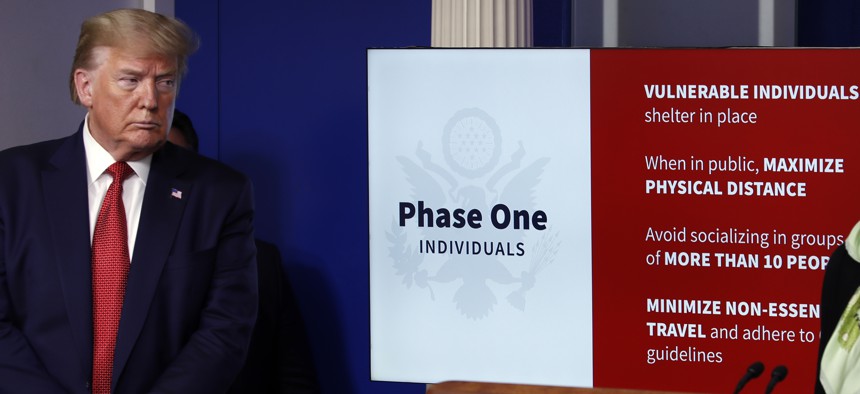White House Plan to Reopen Economy Puts Onus on Governors

President Donald Trump listens as Dr. Deborah Birx, White House coronavirus response coordinator, speaks about the coronavirus in the James Brady Press Briefing Room of the White House, Thursday, April 16, 2020, in Washington. AP Photo/Alex Brandon
The guidance offers a three-phase approach to reopening businesses and schools that recommends states see a 14-day decline in Covid-19 infections before taking action.
The White House issued new guidance Thursday on how states can restart their economies in the wake of the coronavirus pandemic, leaving decisions about timing up to governors.
The plan will guide states on reopening “one careful step at a time” and could enable some states where outbreaks are not widespread to begin reopening as soon as Friday, President Trump said at a White House press conference.
“Governors will be empowered to tailor an approach that meets the circumstances of their own states,” Trump said. “If they need to remain closed, we will allow them to do that and if they believe it is time to reopen, we will provide them the freedom and guidance to accomplish that task.”
The announcement comes as states this week began forming regional blocs to coordinate plans to combat the coronavirus outbreak and restart their economies and as opponents of state stay-at-home orders gathered in several state capitols to protest the restrictions.
The White House’s 18-page plan, which was distributed to governors, offers a three-phase approach to reopening the economy. It recommends before states implement the first step of the plan, they first see a decline in influenza-like illnesses and of positive Covid-19 tests for two weeks. Hospitals should also be able to handle a surge in intensive care unit capacity to handle an uptick in coronavirus cases and have networks to test at-risk healthcare workers in place.
States that meet the criteria and have not seen widespread infection rates could begin to implement phase one of the plan beginning Friday, Trump said, though he declined to name states that could be best poised to reopen.
Balancing the need to reopen the economy with the need to protect public health and prevent a resurgence of the outbreak has proven to be a difficult conundrum. Across the United States, more than 630,000 people have been infected with Covid-19 and upwards of 28,000 people have died from the virus. Schools and businesses have closed to prevent the spread of the virus, and millions of workers have lost their jobs. At least 22 million people have filed for unemployment benefits over the last four weeks.
Members of the White House Coronavirus Task Force said the guidance is meant to provide states with checkpoints to ensure that they do not rush into reopening and see a resurgence of infections.
“There may be some setbacks and we may need to pull back a little and then go forward,” said Dr. Anthony Fauci, the director of the National Institute of Allergy and Infectious Diseases.
Under phase one of the plan, businesses would be encouraged to continue telework for employees when possible and gyms and large venues like restaurants would be able to operate again under strict physical distancing protocols. Schools that are already closed would remain shuttered. Individuals would be instructed to avoid gatherings of more than 10 people and to maintain social distancing protocols when outside the home. Vulnerable people would continue to shelter at home.
Under phase two of the plan, schools would reopen but telework would be encouraged when possible.
Society would largely return to normal activities under phase three of the plan, though individuals would still be encouraged to minimize time spent in crowded environments.
Recent research indicates that Americans are more concerned about lifting social distancing restrictions prematurely than they are about keeping them in place. Pew Research found that 66% of Americans were more concerned that restrictions would be lifted too quickly, while 32% were concerned they won’t be lifted quickly enough.
Plans to reopen the American economy and keep it open will largely rely on the availability of both diagnostic and surveillance testing, public health officials said.
“The major thrust of how we are going to control and continue to keep this nation open is early case recognition, isolation and contact tracing,” said Dr. Robert Redfield, the director of the Centers for Disease Control and Prevention. “As we see cases across the country we will have to jump on them.”
Andrea Noble is a staff correspondent with Route Fifty.
NEXT STORY: Protests Erupt at State Capitols Over Stay At Home Orders





